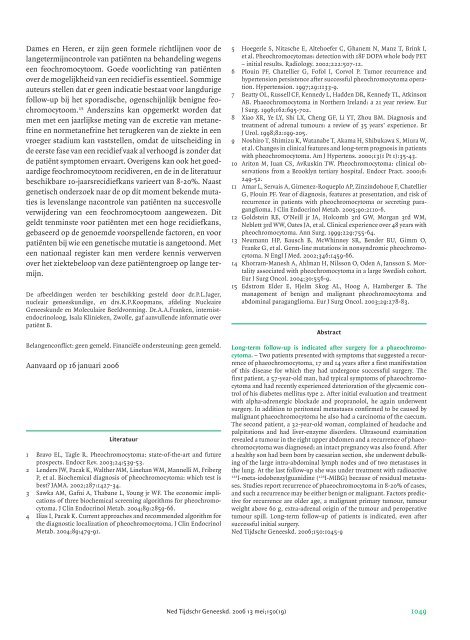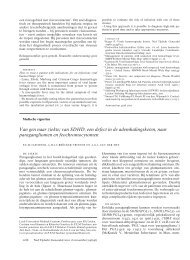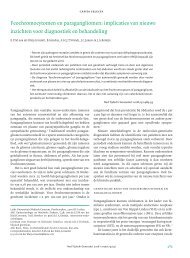Controle na operatie feochromocytoom - Nederlandse Vereniging ...
Controle na operatie feochromocytoom - Nederlandse Vereniging ...
Controle na operatie feochromocytoom - Nederlandse Vereniging ...
You also want an ePaper? Increase the reach of your titles
YUMPU automatically turns print PDFs into web optimized ePapers that Google loves.
Dames en Heren, er zijn geen formele richtlijnen voor de<br />
langetermijncontrole van patiënten <strong>na</strong> behandeling wegens<br />
een <strong>feochromocytoom</strong>. Goede voorlichting van patiënten<br />
over de mogelijkheid van een recidief is essentieel. Sommige<br />
auteurs stellen dat er geen indicatie bestaat voor langdurige<br />
follow-up bij het sporadische, ogenschijnlijk benigne <strong>feochromocytoom</strong>.<br />
15 Anderszins kan opgemerkt worden dat<br />
men met een jaarlijkse meting van de excretie van metanefrine<br />
en normetanefrine het terugkeren van de ziekte in een<br />
vroeger stadium kan vaststellen, omdat de uitscheiding in<br />
de eerste fase van een recidief vaak al verhoogd is zonder dat<br />
de patiënt symptomen ervaart. Overigens kan ook het goedaardige<br />
<strong>feochromocytoom</strong> recidiveren, en de in de literatuur<br />
beschikbare 10-jaarsrecidiefkans varieert van 8-20%. Naast<br />
genetisch onderzoek <strong>na</strong>ar de op dit moment bekende mutaties<br />
is levenslange <strong>na</strong>controle van patiënten <strong>na</strong> succesvolle<br />
verwijdering van een <strong>feochromocytoom</strong> aangewezen. Dit<br />
geldt tenminste voor patiënten met een hoge recidiefkans,<br />
gebaseerd op de genoemde voorspellende factoren, en voor<br />
patiënten bij wie een genetische mutatie is aangetoond. Met<br />
een <strong>na</strong>tio<strong>na</strong>al register kan men verdere kennis verwerven<br />
over het ziektebeloop van deze patiëntengroep op lange termijn.<br />
De afbeeldingen werden ter beschikking gesteld door dr.P.L.Jager,<br />
nucleair geneeskundige, en drs.K.P.Koopmans, afdeling Nucleaire<br />
Geneeskunde en Moleculaire Beeldvorming. Dr.A.A.Franken, internistendo<br />
crinoloog, Isala Klinieken, Zwolle, gaf aanvullende informatie over<br />
patiënt B.<br />
Belangenconflict: geen gemeld. Fi<strong>na</strong>nciële ondersteuning: geen gemeld.<br />
Aanvaard op 16 januari 2006<br />
Literatuur<br />
1 Bravo EL, Tagle R. Pheochromocytoma: state-of-the-art and future<br />
prospects. Endocr Rev. 2003;24:539-53.<br />
2 Lenders JW, Pacak K, Walther MM, Linehan WM, Mannelli M, Friberg<br />
P, et al. Biochemical diagnosis of pheochromocytoma: which test is<br />
best? JAMA. 2002;287:1427-34.<br />
3 Sawka AM, Gafni A, Thabane L, Young jr WF. The economic implications<br />
of three biochemical screening algorithms for pheochromocytoma.<br />
J Clin Endocrinol Metab. 2004;89:2859-66.<br />
4 Ilias I, Pacak K. Current approaches and recommended algorithm for<br />
the diagnostic localization of pheochromocytoma. J Clin Endocrinol<br />
Metab. 2004;89:479-91.<br />
Ned Tijdschr Geneeskd. 2006 13 mei;150(19)<br />
5 Hoegerle S, Nitzsche E, Altehoefer C, Ghanem N, Manz T, Brink I,<br />
et al. Pheochromocytomas: detection with 18F DOPA whole body PET<br />
– initial results. Radiology. 2002;222:507-12.<br />
6 Plouin PF, Chatellier G, Fofol I, Corvol P. Tumor recurrence and<br />
hypertension persistence after successful pheochromocytoma operation.<br />
Hypertension. 1997;29:1133-9.<br />
7 Beatty OL, Russell CF, Kennedy L, Hadden DR, Kennedy TL, Atkinson<br />
AB. Phaeochromocytoma in Northern Ireland: a 21 year review. Eur<br />
J Surg. 1996;162:695-702.<br />
8 Xiao XR, Ye LY, Shi LX, Cheng GF, Li YT, Zhou BM. Diagnosis and<br />
treatment of adre<strong>na</strong>l tumours: a review of 35 years’ experience. Br<br />
J Urol. 1998;82:199-205.<br />
9 Noshiro T, Shimizu K, Wata<strong>na</strong>be T, Akama H, Shibukawa S, Miura W,<br />
et al. Changes in clinical features and long-term prognosis in patients<br />
with pheochromocytoma. Am J Hypertens. 2000;13(1 Pt 1):35-43.<br />
10 Ariton M, Juan CS, AvRuskin TW. Pheochromocytoma: clinical observations<br />
from a Brooklyn tertiary hospital. Endocr Pract. 2000;6:<br />
249-52.<br />
11 Amar L, Servais A, Gimenez-Roqueplo AP, Zinzindohoue F, Chatellier<br />
G, Plouin PF. Year of diagnosis, features at presentation, and risk of<br />
recurrence in patients with pheochromocytoma or secreting paraganglioma.<br />
J Clin Endocrinol Metab. 2005;90:2110-6.<br />
12 Goldstein RE, O’Neill jr JA, Holcomb 3rd GW, Morgan 3rd WM,<br />
Neblett 3rd WW, Oates JA, et al. Clinical experience over 48 years with<br />
pheochromocytoma. Ann Surg. 1999;229:755-64.<br />
13 Neumann HP, Bausch B, McWhinney SR, Bender BU, Gimm O,<br />
Franke G, et al. Germ-line mutations in nonsyndromic pheochromocytoma.<br />
N Engl J Med. 2002;346:1459-66.<br />
14 Khorram-Manesh A, Ahlman H, Nilsson O, Oden A, Jansson S. Mortality<br />
associated with pheochromocytoma in a large Swedish cohort.<br />
Eur J Surg Oncol. 2004;30:556-9.<br />
15 Edstrom Elder E, Hjelm Skog AL, Hoog A, Hamberger B. The<br />
ma<strong>na</strong>gement of benign and malig<strong>na</strong>nt pheochromocytoma and<br />
abdomi<strong>na</strong>l paraganglioma. Eur J Surg Oncol. 2003;29:278-83.<br />
Abstract<br />
Long-term follow-up is indicated after surgery for a phaeochromocytoma.<br />
– Two patients presented with symptoms that suggested a recurrence<br />
of phaeochromocytoma, 17 and 14 years after a first manifestation<br />
of this disease for which they had undergone successful surgery. The<br />
first patient, a 57-year-old man, had typical symptoms of phaeochromocytoma<br />
and had recently experienced deterioration of the glycaemic control<br />
of his diabetes mellitus type 2. After initial evaluation and treatment<br />
with alpha-adrenergic blockade and propranolol, he again underwent<br />
surgery. In addition to peritoneal metastases confirmed to be caused by<br />
malig<strong>na</strong>nt phaeochromocytoma he also had a carcinoma of the caecum.<br />
The second patient, a 32-year-old woman, complained of headache and<br />
palpitations and had liver-enzyme disorders. Ultrasound exami<strong>na</strong>tion<br />
revealed a tumour in the right upper abdomen and a recurrence of phaeochromocytoma<br />
was diagnosed; an intact preg<strong>na</strong>ncy was also found. After<br />
a healthy son had been born by caesarian section, she underwent debulking<br />
of the large intra-abdomi<strong>na</strong>l lymph nodes and of two metastases in<br />
the lung. At the last follow-up she was under treatment with radioactive<br />
123 I-meta-iodobenzylguanidine ( 123 I-MIBG) because of residual metastases.<br />
Studies report recurrence of phaeochromocytoma in 8-20% of cases,<br />
and such a recurrence may be either benign or malig<strong>na</strong>nt. Factors predictive<br />
for recurrence are older age, a malig<strong>na</strong>nt primary tumour, tumour<br />
weight above 60 g, extra-adre<strong>na</strong>l origin of the tumour and peroperative<br />
tumour spill. Long-term follow-up of patients is indicated, even after<br />
successful initial surgery.<br />
Ned Tijdschr Geneeskd. 2006;150:1045-9<br />
1049





